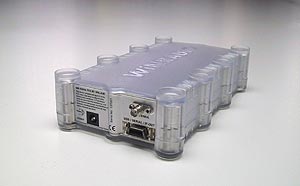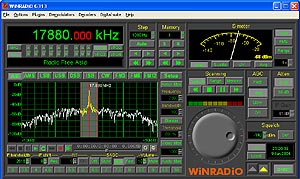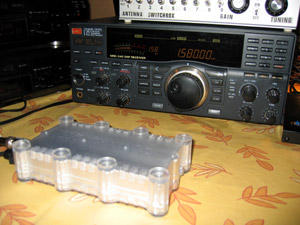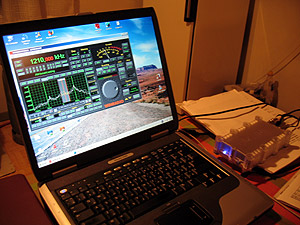|
Review of Winradio WR-G313e
By Mika
Mäkeläinen
When buying a new communications
receiver today, the most important question is whether
to opt for a traditional table-top receiver, or
a PC-controlled receiver. The choice is not easy,
although software-defined receivers (SDR) are improving
all the time. Winradio has recently introduced its
latest PC-controlled model WR-G313e, which is basically
an external version of an earlier WR-G313i receiver.
For a DXer interested in distant mediumwave and
shortwave stations, G313e turns out to be good value
for money. The receiver fares very well in hectic
DXpedition use, but not entirely without shortcomings.
Winradio (or WiNRADiO
as the Australian company prefers to be spelled)
officially introduced its latest software-defined
receiver on October 29, 2005, and kindly provided
the receiver for review. Winradio WR-G313e is an
HF receiver (9 kHz to 30 MHz, optionally extendable
to 180 MHz) with a USB interface. The earlier model
(G313i) was built on a PCI card, so the new G313e
is better for mobile use. It is easy to pack and
take along with a laptop PC. Otherwise the receivers
are identical, and so is the software running them.
 |
WR-G313e is reviewed here based
on usability, and on how well it fits the needs
of DXers hunting for rare mediumwave and shortwave
stations. The receiver has other uses as well, and
DXers can have other priorities. I have compared
G313e to my JRC NRD-545 DSP receiver, and briefly
in DXpedition conditions also to JRC's previous
model, NRD-535G. It must be taken into account that
NRD-545 is much more expensive - sold for around
$1800-1900 in the US and €1800-2200 in Europe
- than G313e, which is priced at around $1200.
Hardware and
software
The hardware part
of G313e is a simple box (measuring 16 x 9 x 4 cm)
with an on-off switch and an indicator light in
one end, and a power jack, USB interface and antenna
plug in the other. An AC/DC adapter and all necessary
cables are provided. The receiver uses an SMA antenna
connection, but a BNC adapter is included.
A beginner's antenna
is included, but you should always use a proper
outdoor antenna for any serious use. Software comes
on a CD-ROM and is easy to install. The user's guide
is detailed and user-friendly.
According to system requirements,
G313e works with a minimum of 500 MHz CPU and 64MB
of RAM, although 1 GHz and 256MB are recommended.
I would go further; an even more powerful PC is
needed, because in practise you would likely be
multitasking. My lap-top is faster than recommended,
but I still experience constant breaks in playback
of IF recordings made with G313e. I first suspected
that slowness was due to a slow USB connection (1.0),
as I used a separate USB hard disc to store IF recordings,
but there was no improvement when I moved the sound
files to the lap-top's own hard drive, nor when
I closed all other visible applications. G313e by
the way is compatible with both USB 1.0 and 2.0
standards.

The control panel of WR-G313e,
click to enlarge |
Software always has its pros
and cons. A software-defined receiver is like good
wine, improving as it matures, because the software
is constantly developed and upgrade downloads are
free. Of course, there is no way around hardware
limitations. However, as any PC user can testify,
software tends to cause nasty surprises. Even though
a particular piece of software would be fine, interaction
with other software is sometimes problematic. In
my case the system kept on crashing on my tabletop
PC, until Winradio engineers figured out the problem
and amended the software - it turned out that an
existing driver in my system didn't get along with
Winradio.
Electrical interference can be
a real nuisance in low-noise environments, so if
you are using a PC-controlled radio, your PC and
AC/DC adapter are potential risks. However, I didn't
notice any interference from my Compaq laptop nor
from the power adapters of the PC or G313e.
User interface resembles a traditional
communications receiver, making it intuitively easy
to use. Frequency controls are placed in the upper
left corner; with mode and bandwidth controls below.
S-meter occupies most of the upper right corner,
with scanning, AGC, attenuator and a large tuning
knob below. Recording and playback keys are located
right below the spectrum display. Preferences in
the locations of various controls are very personal
and depend on what you're used to. As this is all
defined by software, perhaps a step forward would
be the possibility to drag and drop various parts
of the interface where-ever you want them to be
located, and hide controls which you don't need
on a daily basis.
Additional buttons on my wish-list
would be quick access buttons for memory files.
There should be at least 10-20 such small buttons,
one for each memory file. This would make changing
from one memory file to another much faster than
the present system of opening boxes and files in
the traditional Windows way.
Tuning
There are several ways to choose
the frequency. You can type digits on your keyboard
and further adjust the frequency using sliders or
up/down buttons next to the frequency display. An
incremental tuning pad has adjustable steps. There
is a tuning knob with variable speeds, but it takes
some getting used to, as handling a mouse is never
the same as using your finger. It just doesn't feel
the same… but as I have been reminded, on the
market there are hardware tuning knobs as accessories
for nostalgic users.
A newer function is "tune
to peak" which automatically finds and tunes
to the strongest signal within the IF range, but
this is useful mainly in FM or utility listening.
Frequency-hopping steps can be
adjusted freely. In practise you can try 9 and 10
kHz intervals on mediumwave and 5 kHz on shortwave.
To switch frequencies, I prefer to use page up/down
keyboard buttons instead of clicking the small controls
on the software interface.
Instead of frequency stepping,
I still prefer to store MW and SW frequencies in
a memory file, because it allows you to for example
preset the better sideband separately for each frequency.
On the downside, page up/down doesn't work when
browsing memorized frequencies, so it is not quite
as convenient as regular frequency stepping.
Controls and
Settings
All necessary broadcast modes
are supported, including DSB (dual sideband), not
found in conventional receivers. ISB (independent
sideband) gives you the option of recording both
sidebands simultaneously as a stereo recording.
There are several ways to set
the bandwidth. A row of 15 fully adjustable buttons
shows a range of preset values for each mode. There
is also a control button with a slider to adjust
bandwidth, or you can type the bandwidth. I would
normally use SSB and a bandwidth of 2.7-2.9 kHz.
All the necessary controls are
included, such as pass-band tuning (PBT), automatic
gain control (AGC), notch filter and noise blanker.
There is actually a double-AGC, a hardware AGC and
a software AGC, which can be operated independently.
The notch filter is remarkably effective and easily
adjustable. It seems to work as well as that of
NRD-545, which is superior to previous JRC models.
As a bonus, you can even adjust the width of the
notch filter.

Setup button opens another
window, which includes settings for example
for recording and audio filter |
An audio filter (located and
defined under a separate setup page) can and should
be used to improve sound quality, which of course
is a highly personal matter. In my opinion the NRD-545
still has better sound quality. In G313e, a decent
sound quality is achieved by cutting off audio below
250-300 Hz. The upper limit would normally be defined
by your bandwidth.
To take full advantage of the
range of controls available, it is a good idea to
make an IF recording (see "Recording"
below) whenever you are monitoring something important,
and play with the settings safely afterwards.
A striking novelty compared to
conventional receivers is a large real-time spectrum
display, a feature that has been confined to top-class
communications receivers, but is standard in software-defined
receivers. Normally the spectrum trace would move
so rapidly that I prefer to smooth the image with
a video filter (mine is set at 3000 Hz). In addition
to the previously listed tuning and bandwidth setting
methods, you can use a slider on the display to
change frequency or set the bandwidth. The display
of course doesn't improve reception a single bit,
but I admit that it is fun to also "watch"
what you're listening.
Memories
Though not really a memory, four
VFO buttons located next to the frequency display
in practise allow you to have three additional "fast"
memory channels just a click away, without needing
to browse your memory files. This may be useful
especially during those crucial seconds when you
are hunting for a top-of-the-hour station identification,
enabling you to earmark the most interesting ones
for instant access.
The same outcome with even more
channels can be achieved through the memory function,
but setting the memory channels takes much more
time. 11 stations in each memory file can be assigned
a hotkey (one of the function keys on the keyboard)
for quick retrieval.

Two receivers that have
enough memory capacity; JRC NRD-545 (behind)
has 1000 memory channels, but Winradio WR-G313e
even more. |
The memory capacity is in practise
unlimited. Each memory file can hold 1000 channels,
and you can create as many memory files as you can
fit in your computer.
For example mode, IF shift and
bandwidth can be stored with each memory channel.
Also a short text can be associated with each memory
channel. This can be used for example to indicate
the name, call, slogan or format information of
the desired station.
Initially I started copying the
same frequency list which I had created for my NRD-545
as a single 1000-station long memory file, but it
turned out to be unpractical. I had listed the same
frequency in various contexts (1260 kHz for example
has interesting stations on several continents),
but G313e however only showed one station name with
each listed frequency, so in many cases the text
shown would refer to a wrong station on the same
frequency.
So I decided to create memory
files with a narrow scope, one for each target area,
country or even one file for a single network (such
as Japanese NHK-1 stations). In addition, for more
general purposes, I have created for example a file
containing all MW channels at 9 kHz intervals. The
settings have of course been made according to my
preferences (for example bandwidth at 2.6 kHz),
and either LSB or USB has been chosen to avoid nearby
American frequencies (each 10 kHz) as well as European
DRM transmissions on adjacent channels. You can
download it here,
and modify according to your needs, so you don't
need to start from scratch. I think it would be
excellent customer service if the manufacturer could
provide a library of memory files for different
uses.
Recording

The center of the spectrum
display is between two peak signals, indicating
that an IF recording is taking place |
An essential part of any serious
DXing is recording what you hear for future research.
G313e has an integrated recorder with playback.
Recordings are automatically saved in standard .wav
format, which is sufficient, but a possibility to
use .mp3 would save disc space. As recording is
part of the software, we can hope that MP3 recording
would become possible in the future.
If you have a clear signal and
there is no doubt about what settings are the best,
regular recording is the way to go. However, if
there is any kind of interference or noise, or if
you would need to change any settings at any point,
you should opt for IF recording.
IF recording saves a 20 kHz wide
frequency spectrum, meaning that for example on
the mediumwave band (where stations are either 9
or 10 kHz apart), you can record two (but not three)
frequencies simultaneously. On shortwave, in case
stations are 5 kHz apart, you can monitor even three
channels.
IF recording on LEM214
DXpedition
Here is an example of what a graveyard watch
done with IF recording netted during my recent
DXpedition to the Finnish Lapland. On Sunday,
October 30, I monitored 1230 & 1240 kHz
most of the time from 0730 to past 1300 UTC,
using an antenna pointed at 336 degrees. This
is the antenna to listen to US and Canadian
stations west of the Rockies. Conditions were
relatively good, though steadily focused on
Oregon, from where the usual suspects were heard.
On 1230 kHz, aside from CBQC Ft. Providence
NT (with national CBC programming), KKEE Astoria
OR was identified at 0800, 1156-1200, 1256 and
1300 UTC. KORT Grangeville ID was heard briefly
at 1023 UTC. A couple of unidentified stations
were present, probably including KMUZ Gresham
OR, judging by the format. On 1240 kHz, KTIX
Pendleton OR was dominant, identified at 0743,
0759, 0900, 0903, 1200 and 1203. KWIK Pocatello
ID was identified at 0759, KQEN Roseburg OR
at 0919, and KEJO Corvallis OR at 1300 UTC. |
Although it takes more disc space,
IF recording is a real time machine. It records
everything that happens on the chosen segment. During
playback, you can change frequency up to 7.5 kHz
(with the settings that I have used) in either direction,
and you can change and compare any demodulator functions
(mode, bandwidth, notch filter etc) as much as you
like, and always find the ideal settings for the
final recording.
Especially on DXpeditions you
sometimes encounter so good conditions that you
don't really know what to choose from the multitude
of interesting stations. IF recording can double
your chances. For example, on my recent LEM214 DXpedition
I would often set the IF recording at 1235 kHz,
whenever North American stations were audible on
the graveyard frequencies of 1230 and 1240 kHz (see
box above right).
IF recording was exceptionally
useful when monitoring channels with one or more
signals that were off the nominal frequency. Normally,
if you would use LSB/USB while listening, and any
signal would be roughly 0.05 kHz or more off, you
would need to choose what to monitor, and lose other
signals. With IF recording you can catch all signals
no matter how far off they are, and adjust IF shift
individually for each offset station during playback.
In practise this is very convenient especially with
Latin American and Philippine AM stations, as well
as X-band Australians, but there are unstable AM
stations on all continents (see box on right with
audio samples).
|
Audio samples of normal and IF recording
Here are a few examples of recordings made
with different settings. CFUN Vancouver BC
on 1410 kHz is a common station in Lapland,
this station ID was recorded on November 1,
2005, at 0806 UTC. AGC was set at medium,
audio filter cut-off low at 300 Hz either
on or off. MP3 format (22050 Hz, 48 kb/sec,
mono).
- LSB,
2.9 kHz bandwidth, filter on
- LSB,
2.6 kHz bandwidth, filter on
- LSB,
2.6 kHz bandwidth, filter off
- DSB,
5.5 kHz bandwidth, filter on
- AM,
6.0 kHz bandwidth, filter on
- AM,
6.0 kHz bandwidth, filter off
Note also that there are short blackouts and
breaks in just about every recording because
of computer not being fast enough. Also note
that under more interference, SSB and filter
use would make a much more significant difference.
Finally, an example of the possibilities
offered by IF recording. Setting IF frequency
at 1565 kHz, I was able to record both 1560
and 1570 kHz, and possible split frequencies
as well. During the wee hours of November
5, 2005, conditions favored Brazil. At 0300
UTC I caught Rádio
Educadora, Jaguaquara BA on 1569.74 kHz,
and at 0400 UTC Rádio
ABC, Santo André SP at exactly 1570
kHz. And I have yet to check my recordings
on and around 1560 kHz...
|
IF recording is so neat that
it makes you wish that the frequency range would
be even wider, allowing you to capture larger segments
of the band, which is indeed possible with some
other software-defined receivers. Then you could
easily spend the rest of the year reliving your
DXpedition highlights.
Other functions
G313 has comprehensive scanning
functions, which are of limited use for a broadcast
band DXer, whose main problem is to find an interesting
station among others considered as interference,
and not so much to spot an isolated signal from
a large frequency spectrum full of only noise.
Another feature less used by
BCB DXers is a spectrum analyzer, which in itself
is of course a nice function not traditionally included
in a receiver. Unlike the spectrum display in the
demodulator panel (part of the front user interface),
the spectrum analyzer - which opens an extension
to the interface - can cover a wide frequency range.
The spectrum analyzer constantly sweeps across the
desired frequency spectrum creating a graph illustrating
all signals. This may be useful if you are listening
in low-interference conditions, and want to keep
an eye on a range of normally empty channels, in
the hope of something to pop up.
A nice asset for the future is
that a DRM decoder can be added as a plug-in to
the receiver, for a price though.
Comparison
G313e is sensitive enough for
serious DXing, and according to measurements published
earlier, sensitivity is very stable across the frequency
range. During the few weeks that I have used the
receiver, the same stations have been audible on
both NRD-535/545 and G313e. However, occasionally
overloading seems to be a problem. I noticed this
especially on two instances. At home I have a 50-kilowatt
MW transmitter just 10 kilometers away, causing
spurious signals. Also on a DXpedition in Lapland,
where interference levels are much lower, I still
got a lot of unwanted spurious signals on the extended
MW band (1610-1700 kHz), when I was hunting for
weak Australian stations using huge beverage antennas.
NRD-545 had the same problem to a lesser extent,
but a modified NRD-535 fared somewhat better than
NRD-545.
G313e already has excellent usability,
and further improvements can be expected in the
future as the software is developed. JRC NRD-545
excels in usability, when compared to previous NRD
models, but in many respects, G313e goes even further
and provides much more versatility in controlling
various receiver functions. NRD-545 was the first
NRD model to have enough memory channels, but also
here the software-defined G313e is superior. Ergonomics
is more a matter of taste. If you are comfortable
with using a mouse, ergonomics is not an issue,
and the receiver is a pleasure to handle.
Winradio has trademarked its
slogan "… the future of radio" -
and indeed, G313e certainly is an indication of
where receiver development is heading to. In my
opinion, G313e doesn't yet take us far enough into
the future to say goodbye to the best conventional
table-top receivers, but it is still a great receiver
packed with a lot of new exciting and useful features.
Published on DXing.info
on November 27, 2005
  
|